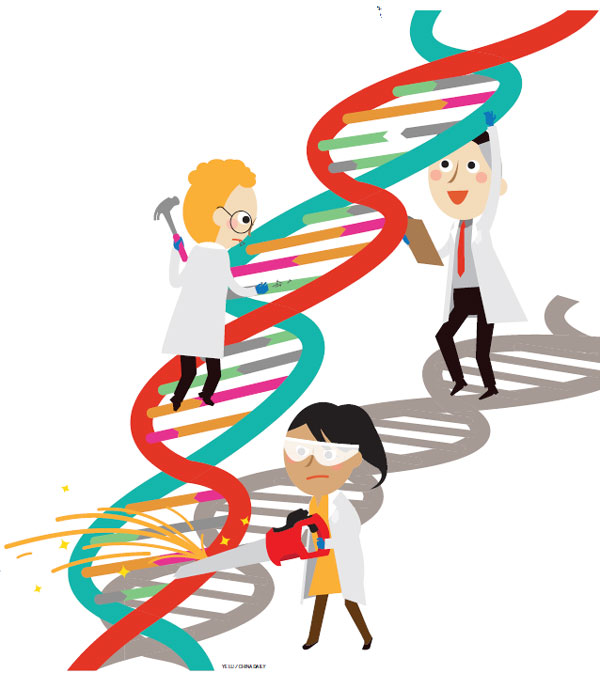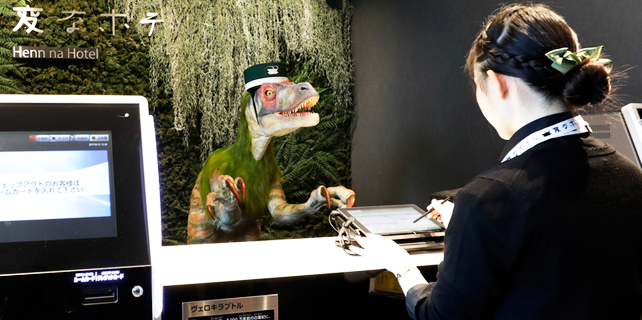Editing the book of life

Researchers in China, the United States and elsewhere are using a unique technology known as CRISPR-Cas9 to edit DNA. CRISPR has potential as a tool for treating a range of diseases, engineering food and even human life, Christopher Davis reports from New York.
It's the most promising - and frightening - frontier in modern science.
Not just reading the human genome, but editing it, rewriting code crafted over eons of evolution in a matter of hours. It's virtually as simple as a find-and-replace function on a laptop word processor.
In 1978, visionary science fiction writer Isaac Asimov wrote: "The advance of genetic engineering makes it quite conceivable that we will begin to design our own evolutionary progress."
Fast forward 39 years to South by Southwest March 11, 2017.
Jennifer Doudna, professor of molecular and cell biology and chemistry at UC Berkeley tells the audience in no uncertain terms: "As human beings, we now have the ability to control our own evolution. We can make changes to our own DNA that will be inherited by future generations - an awesome power."
It's all come about quickly through a technology that is not even five years old, a biochemical process evolved by bacteria to fend off infection by viruses that Doudna and her French, trans-Atlantic co-researcher Emmanuelle Charpentier copied and have developed into a scientific tool that is changing everything. Asimov would be impressed.
It's called CRISPR-Cas9 and it has made genetic engineering chores that used to take months or even years of trial and error or cross breeding something that can be done in a matter of hours.
In part because it is so inexpensive, fast and simple to use, it is taking off in the world of science (the number of scientific papers with CRISPR in their titles went from 90 in 2012 to more that 741 in 2016), and in the process, raising ethical concerns.
Just last week, researchers at the Guangzhou Medical University announced that they had successfully used CRISPR on viable human embryos with the aim of editing out genetic mutations known to cause diseases. Attempts in 2015 to delete the mutation that causes beta-thalassemia were successful in only one out of 10 cases.
In the current study, scientists used donated immature eggs, fertilizing six with sperm from two men who each carried a different genetic mutation - one for favism and one for beta-thalassemia. Using CRISPR, the team fixed one embryo fully and some of the cells in two other embryos.
Learning tool
In Sweden, scientists are also using CRISPR not so much to edit embryonic genes as much as learn how the genes work.
"If we can understand how these early cells are regulated in the actual embryo, this knowledge will help us in the future to treat patients with diabetes, or Parkinson, or different types of blindness," said developmental biologist Fredrik Lanner of the Karolinska University in Stockholm, who recently allowed NPR exclusive access to his lab.
Lanner called CRISPR "a game changer."
"It's not just quicker or cheaper," he said. "This actually opens the door to start to look at this for the first time, because we could not do this at all previously in the human embryo. The technology was just not efficient enough to try to look at the individual gene function as the embryo develops."
Doudna believes "democratizing" such a powerful but accessible tool opens doors in labs all over the world. She listed some of the avenues of research for the audience at South by Southwest.
In agriculture, animals and plants can be precision edited to avoid some of the unintended negative genetic traits that come along with the traditional methods of genetic engineering.
She also noted the clinical trial underway in China fighting lung cancer. The world's first gene-editing trial in humans, teams at Sichuan University's West China Hospital removed immune system T cells from patients and used CRISPR to switch off the cells' mechanism that puts the brakes on its immune response, an inhibitor that inadvertently allows the growth of cancer. Doudna described the process as "making the immune system more capable of finding and destroying cancer cells."
The results of this clinical trial are highly anticipated.
A similar study planned at the University of Pennsylvania has been approved by the US National Institutes of Health and is awaiting final approval from the Food and Drug Administration. In that trial, T cells will be removed from 18 patients with several types of cancer - including melanoma, sarcoma and myeloma - and the cells will be edited to switch off the inhibitor but also be fitted with a protein that will help them locate and attack tumors more easily.
Aside from clinical trials on humans, CRISPR is finding its way into a variety of roles in what some scientists are calling a wave that is "revolutionizing life." There are plans to engineer mushrooms that don't turn brown, find and delete the allergens from peanuts, target illnesses such as cystic fibrosis, sickle-cell anemia and Huntington's disease.
In theory, mosquitoes can be edited to deprive them of their ability to carry malaria. CRISPR is already editing pig DNA to make their organs more suitable for transplant into humans and there is even a project afoot to bring back the woolly mammoth.
Using CRISPR to study elephant DNA, the Harvard Woolly Mammoth Revival team says its goal is not so much to make perfect copies of mammoths but to better understand the genetic traits that made Indian elephants more adapted to the tundra and boreal forests of the frigid north. By identifying the links between genes and adaptations, Dr Sergey Zimov and his team admit that they will be laying the groundwork for the "de-extinction of mammoths" 10,000 years after they disappeared from the planet. Move over Jurassic World, Pleistocene Park's on its way.
The tundra, Zimov explained to a Harvard publication, was once a vast grassland crawling with antelope, horses and mammoths. When these herds vanished, the new tundra that arose began contributing to climate change. With no grasslands as insulation, the permafrost began melting, releasing greenhouse gasses that have been trapped for tens and hundreds of thousands of years - "the equivalent of burning all of the world's forests two and a half times over."
Desired mutations
Doudna likes to emphasize the many ways better gene-editing can promote global health. "At UC Berkeley we have the expertise in plant science and microbiology research to make a real contribution by designing higher-yield, more pest-resistent crops that a large portion of the world's population depend on," she said.
Doudna's colleague, UC Berkeley plant and microbiology professor Brian Staskawiczs, envisions using CRISPR to create desired mutations in breadbasket plants such as wheat, corn and rice, as well as plants important to the developing world like cacao, coffee and cassava.
"Many genes that plants breeders want to use to improve crops come from related wild species, but when you make a genetic cross, you bring in genes that you don't want," Staskawicz said. "CRISPR-Cas9 will allow you to take just the gene of interest from a wild species and insert it directly in a defined location in an advanced elite seed.
"It is really going to be an advanced breeding tool to make designer plants," he said.
CRISPR faces controversy on two fronts - who actually invented it and who's going to control how far it goes.
Last month the US Patent and Appeal Board found that CRISPR technology actually belongs to a team at Harvard/MIT. In 2012, Doudna and Charpentier had published their ground-breaking paper showing that it was possible to use the CRISP mechanism from bacteria to precision edit genes.
A few months later in 2013, Feng Zhang at the Broad Institute at MIT and George Church at Harvard Medical School showed that it was possible to use the technology to edit the genomes of mice and humans.
Zhang was awarded patents in 2014 and 2015. Doudna and Charpentier challenged that they had come up with the technique first. The patent office decided in Zhang's favor, saying his work was sufficiently different from Doudna's.
Doudna may appeal, but in what has now become a widely circulated statement, Doudna told reporters she wasn't really worried.
Her patent would cover CRISPR use in all cells, she explained. Zhang's patents covered plants and animals only. "They will have the patent on green tennis balls," she said. "We will get a patent on all tennis balls."
The rivalry could very well be quelled when all of them are jointly award a Nobel Prize, which would surprise no one in the world of science, given the profound the impact what's been called the scientific breakthrough of the century is having.
Proceed with caution
But the dark side of the technology has also had ethicists burning the midnight oil. Fears of tinkering for designer babies, genetic editing for muscle mass or height or intelligence, or even lethal superbugs that could be weaponized led to a convention of 22 experts from the world over who want to give CRISPR the red light, or at least a proceed-with-caution yellow one.
A gene-editing summit met at the National Academy of Sciences last December and their report was just issued. It recommends an absolute ban on "germline" editing - that is changes to eggs, sperm or embryos that would alter the adult and be passed down through subsequent generations. And they came out strongly against the use of CRISPR for any cosmetic enhancements.
But the report does take a forward-looking stand on the use of the technology. Once procedures are proven safe, then by all means they should be used.
The key is more and more studies and evidence. "We are not even close to the amount of research that we need before you can move forward," said Alta Charo, a University of Wisconsin professor of law and bioethics who co-authored the report.
"The science is moving fast," said Richard Hynes, an investigator at Howard Hughes Medical Institute and co-chair of the committee. "You want to have good control of what is being done."
Asked by a member of the audience at South by Southwest what worried her the most about CRISPR, Doudna said people getting out ahead of the technology, over extension or "creating harmful effects that may turn the public against it."
A cheap, easy to use tool that transforms the book of life into a digital document where individual genes can be searched out and erased or replaced at breakneck speeds - that sounds like one genie that's not going back in the bottle any time soon.
Another co-author of the report, Janet Rossant, emeritus chief of research at Toronto's Hospital for Sick Children, cut to the chase. "The bottom line is the potential to be able to fix genetic disease is here."
Contact the writer at chrisdavis@chinadailyusa.com
















